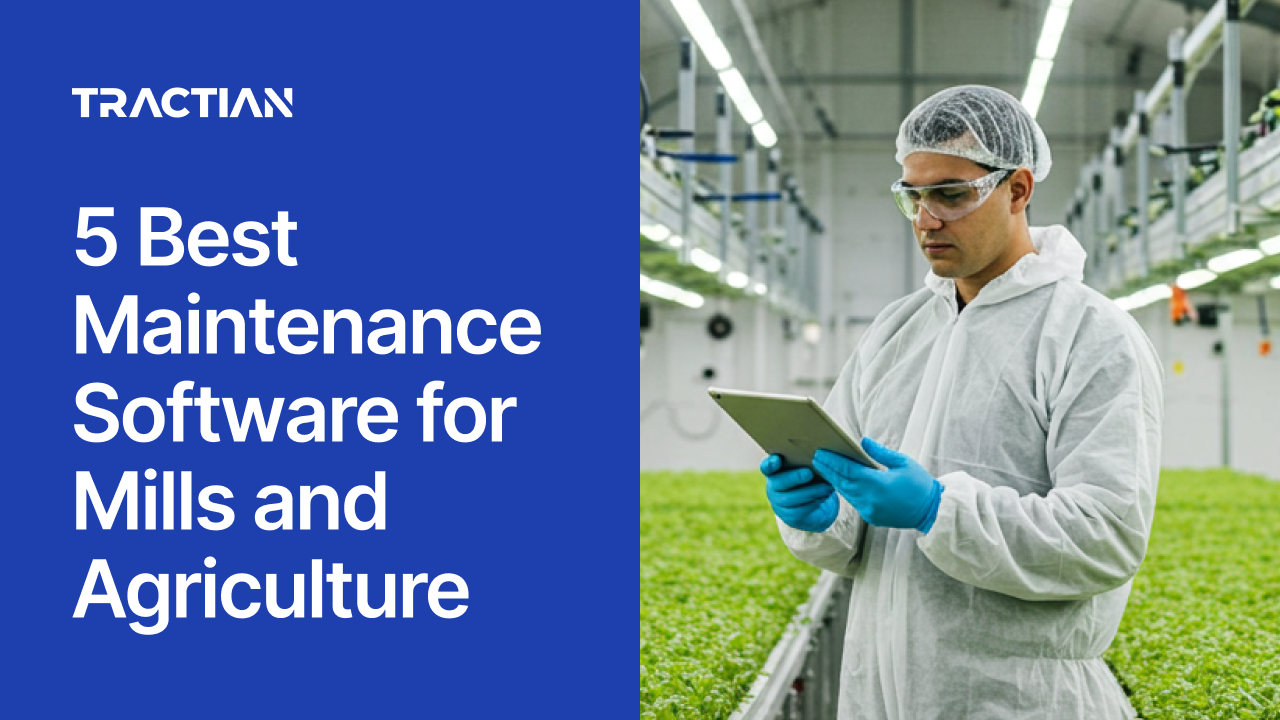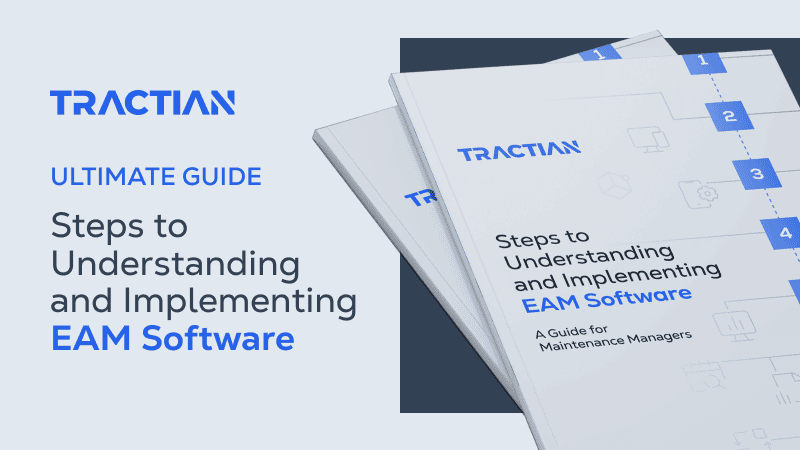When a feed mill goes down in peak harvest, you don’t just lose hours. You lose product, contracts, and profit. Same for a grain elevator with a dead conveyor, or a dairy plant held up by a missed lubrication. In Mills and Agriculture industries, uptime means the difference between shipping and spoilage.
Yet, too many maintenance teams are still relying on spreadsheets, whiteboards, or outdated desktop systems that don’t survive in the field. They fall short on visibility, standardization, and speed. Worse, they leave you flying blind when you’re trying to coordinate across remote facilities, mobile teams, and hundreds of assets, all with tight margins and no time for guesswork.
That’s where CMMS software built specifically for Mills & Agriculture comes in. It may sound like a myth, but they truly exist and can make industry routines much easier.
In this guide, we break down the 5 best maintenance platforms for mills and agriculture in 2025. These aren’t simply generic work order tools, but systems built to deliver structure, traceability, and execution, and they work whether you're running an industrial mixer, a center pivot, or an entire line of augers across multiple sites.
Let’s get into what makes Mills and Agriculture maintenance different, and why choosing the right platform could mean the difference between falling behind and staying one step ahead.
Why Maintenance in Mills and Agriculture Has a Different Set of Rules
No other sector combines such extreme operating conditions with such a wide range of machinery. You’ve got field assets running off-grid, mobile teams servicing pivots in remote areas, and fixed equipment like grain dryers or pellet mills that can’t stop, not even for a day.
And unlike other industries, agricultural plants and milling facilities face hard calendar constraints. Miss a planting or processing window, and there’s no catching up.
At the end of the day, you’re not just managing uptime. You’re managing climate variability, worker shortages, and pressure from tight margins. That’s why maintenance alone isn’t enough if it means just filling out a checklist. There's got to be some kind of assurance that tasks get done on time, with the right SOP, and in the right order, even when internet access is down or the team is split across locations.
The right CMMS must support this complexity without adding friction. It needs to enforce routines, centralize data, and give your team total visibility into what’s working, and what’s slipping, without depending on desktops or paperwork.
What to Look for in a CMMS for Agricultural Plants and Milling Facilities
In this sector, downtime is not the only villain. When it comes to elevating your operation, you have to successfully manage harvest windows, high-volume processing, remote assets, and strict regulatory oversight. Luckily, a CMMS can help, but the system you choose must be built for that level of complexity.
Here's what separates the tools that work from the ones that slow you down:
Mobile-First, Offline-Capable for Field and Facility Use: From grain dryers in rural zones to conveyors inside a feed plant, your teams don’t always have a stable signal. Your CMMS must work seamlessly in low-connectivity environments, capturing inspections, repairs, and inventory usage even when offline.
SOP Enforcement That Matches Feed Safety Protocols and Sanitation Cycles: Standard Operating Procedures are essential when it comes to FSMA, HACCP, and every internal audit. Your CMMS should embed step-by-step SOPs into each task, ensuring nothing skips, from proper mixer washdowns to safety checks on augers.
Inventory Linked to Every Asset: Bearings, Belts, Lubricants, Filters: Maintenance at scale demands precision. Your team should never guess which V-belt fits a roller mill or what grease is rated for a certain gearbox. The CMMS must automatically tie each part, lubricant, and tool to the asset and task, with alerts before stock runs low.
Real-Time KPIs Across Lines and Locations: Waiting until month-end to know how many hours your pellet mill was down? Too late. A strong CMMS gives instant visibility into MTTR, overdue work, and recurring failures across equipment and sites, whether you're managing a single co-op facility or multiple grain elevators.
Work Scheduling That Adapts to Harvest Cycles and Equipment Criticality: Harvest timing, weather delays, and production loads constantly shift. Your platform should let you reprioritize PMs and repairs based on real-time conditions, instead of fixed calendars, so techs can focus on the equipment that risks throughput.
Fully Audit-Ready Logs: When inspectors show up, you need digital records that match the last work done on every blender, bin, and bagging line. Tasks should be timestamped, linked to a technician, and exportable without manual digging.
Multi-Site Oversight Without Manual Reconciliation: Whether you manage one soybean processing plant or five feed mills, your CMMS should let you compare performance, standardize SOPs, and enforce consistency, all from a single dashboard.

That being said, let's go right into the top 5 best maintenance software for agricultural plants and milling facilities.
1. Tractian
Best for: Teams that need AI-driven SOPs, offline execution, and full asset visibility, whether they’re managing a feed mill, grain elevator, or irrigation equipment in the field.
Tractian isn’t another desktop-first tool retrofitted for plant use. It’s built floor-first (and field-ready) from day one. That means your technician can complete a lubrication route on a rotary screener with no internet and still sync all records automatically when back online.
Its AI transforms tribal knowledge into detailed, equipment-specific SOPs, so tasks like pellet mill inspections, sanitation between ingredient batches, or vibration checks on hammermills aren’t just logged, they’re done to spec. And they can’t be closed out unless the checklist is fully completed.
Every feature is built to support operations under real pressure: sudden harvest spikes, tight FDA audits, or unplanned downtime on mission-critical assets. With mobile-first UX, automatic parts linkage, and built-in failure diagnostics, Tractian gives maintenance teams the structure and visibility to act before breakdowns happen.
Key Features
- AI-generated SOPs embedded in every work order: automates procedures for lubrication, inspection, and sanitation.
- Offline mobile access: ideal for remote farms, field equipment, and poor network zones.
- Work orders tied to parts, tools, and asset BOMs: eliminates mistakes and delays from missing or incorrect materials.
- Live MTTR, MTBF, and backlog dashboards: track reliability across silos, lines, and entire facilities.
- Predictive diagnostics with sensor integration: detects anomalies in vibration, temperature, or runtime before failure escalates.
- Fast deployment with white-glove onboarding: Tractian imports all your Excel routines, inventory, and PM plans out of the box.
What Real Customers Say
- “I like that I can track all of our assets from one location. If a motor is having issues in one part of the plant , and then another on the other side of the plant I am able to basically troubleshoot both motors in one location", says Nicholas D., who works as Maintenance Lead Supervisor in an Enterprise.
- “The ease of tracking equipment without having to constantly observe. Tractian does the work for you", says Jordan D., who works as Maintenance Supervisor in an Enterprise.
Pricing
- Standard Plan: From $60/user/month (minimum 5 users, billed annually)
- Enterprise Plan: From $100/user/month (minimum 10 users)
- Custom Bundles: Available for combining CMMS with Tractian’s condition monitoring sensors
All plans include offline mobile execution, AI-powered SOPs, and full onboarding, including data import, training, and support. Also, there's a free trial available.
2. UpKeep
Best for: Teams beginning digital transformation that prioritize fast deployment over structured execution and compliance depth.
UpKeep works well for basic needs. If your priority is logging preventive tasks on tractors, dryers, or conveyors without getting bogged down by clunky setups, it gets the job done.
But the simplicity can come with a cost. The platform lacks native SOP enforcement, audit-ready records, and dynamic task prioritization. That means more manual oversight to ensure tasks are actually completed to spec, something that can be risky in regulated facilities or high-throughput operations.
For small farms, co-ops, or maintenance teams just starting digital transformation, UpKeep offers a quick path to digitization. Just don’t expect it to scale easily with complex assets, multi-site operations, or compliance-heavy environments.
Key Features
- Mobile task logging: Create, update, and close work orders from any device.
- Preventive maintenance scheduling: Set recurring tasks based on time or usage.
- Basic parts tracking: Tie inventory items to work orders for quick lookups.
- Simple work order history: View task logs and attachments in a centralized place.
- Quick implementation: Setup and onboarding can be completed in days.
What Real Customers Say
- “Everything pops back up a year or more later. It could be something on our end, but it is frustrating having work orders pop back up over a year later”, says Jake S., who works in a Mid-Market company.
- “Simple to use, [but there's a] lack of basic features loading files into folders to keep things organized”, says Richard R., who works in a Small-Business.
Pricing
- Lite Plan: From $20/user/month – basic work orders and PM scheduling
- Starter Plan: $45/user/month – adds inventory and analytics
- Professional Plan: $75/user/month – includes requests portal, workflow automation, and advanced features
- Business+ Plan: Custom pricing for large-scale teams
UpKeep is easy to roll out, but advanced functionality requires higher-tier plans, and even then some teams report friction. There’s no built-in SOP enforcement or audit-grade task traceability, so you’ll need to manage that manually or with custom processes.
3. Fracttal One
Best for: Teams that need centralized asset control and mobile inspection workflows without complex customization.
Fracttal One offers a clean interface and solid mobile functionality. Its strength lies in asset control and mobile usability, especially for teams managing a diverse fleet of equipment across locations.
For agricultural operations and mills, Fracttal offers useful tools like route-based inspections, mobile checklists, and asset history tracking. But it stops short of delivering deeper automation. There's no AI engine to enforce SOPs or flag risks early. Predictive insights and automated diagnostics require manual setups or integrations.
It’s a step above basic systems, and a fit for teams that want visibility and mobile access, but it’s not purpose-built for high-risk, compliance-heavy production environments.
Key Features
- Mobile checklists and inspections: Teams can complete tasks and log data from the field.
- Asset hierarchy and tracking: Supports full asset trees and lifecycle histories.
- Work order scheduling and tracking: Calendar and meter-based preventive routines.
- Basic inventory control: Track usage and link parts to assets.
- Reports and dashboards: View basic metrics and status summaries across teams.
What Real Customers Say
- “It has many built-in utilities, in case all the information is uploaded. The metrics are real. [But] the menu is not very user-friendly at a basic level”, says Paulina Andrea, who works in the Mid-Market.
- “Good task manager, with many opportunities for improvement”, says Iván G., who works in Mid-Market.
Pricing
- Free Plan: Limited users and core features only
- Basic Plan: Starts at ~$40/user/month – includes asset tracking, work orders, and mobile app
- Professional Plan: Custom pricing for advanced features like integrations and dashboards
Fracttal One covers the basics well and stands out for mobile inspections. But without built-in SOP enforcement or predictive tools, it may fall short for ag teams facing heavy compliance or production pressure.
4. MicroMain
Best for: Centralized teams that prioritize depth of data and asset history over mobile execution or predictive insights.
MicroMain is not as modern in look or mobile-first in design, but it offers broad functionality, especially for teams that require detailed asset records, preventive scheduling, and reporting.
For mills and agriculture, MicroMain works well when operations are centralized and managed from a desktop environment. It handles complex asset hierarchies, recurring PMs, and part consumption tracking with solid accuracy.
However, mobile capabilities and technician-facing usability are not its strengths. Field teams often struggle with clunky interfaces or the need for VPN access to run tasks away from the plant.
Key Features
- Asset tree with full lifecycle tracking: Manage data-rich profiles for equipment and components.
- Customizable preventive maintenance routines: Build task libraries and PM schedules by time, usage, or condition.
- Inventory and part management: Link tools and spares directly to work orders.
- Reporting and dashboards: View performance, cost, and compliance metrics at the planning level.
- Integration support: Compatible with ERP and purchasing systems through API and custom connectors.
What Real Customers Say
- “We like the ease of use. It is very user friendly (except scheduler)", says a Verified User in Mid-Market.
- “Comprehensive system with some issues”, says a Verified User in Food Production.
Pricing
- Standard Plan: From $89/user/month – includes PM scheduling, asset tracking, and inventory control
- Enterprise Plan: Custom pricing – adds integrations, analytics, and configuration options
MicroMain delivers on asset depth, PMs, and planning visibility. But it requires consistent network access and isn't built with field usability in mind, so if your teams are mobile or offline often, it might create more friction than value.
5. eMaint (by Fluke)
Best for: Teams with strong internal support that need flexibility, reporting depth, and integration with condition monitoring tools.
eMaint can be a good choice for organizations that want strong reporting, modular features, and integration potential with tools like Fluke sensors. In the context of agricultural and milling operations, eMaint offers a balance between basic task tracking and more advanced maintenance planning.
Although it's a flexible software, and possible to be tailored to fit a variety of workflows, many users report a steep learning curve, especially when configuring SOPs, custom reports, or dashboards.
Field usability is decent, but the mobile experience isn’t as seamless as newer platforms. Also, offline access is limited, and features like in-task SOP guidance or failure diagnostics are either basic or need to be built out manually.
Key Features
- Customizable dashboards and workflows: Tailor views, fields, and processes by site or department.
- Asset management and preventive scheduling: Supports asset trees, task libraries, and calendar- or meter-based triggers.
- Inventory and purchasing module: Track parts, reorder points, and vendor data.
- Condition monitoring integrations: Pulls data from Fluke tools for vibration, temperature, and electrical health.
- Audit-ready reporting and logs: Strong data retention and export capabilities for compliance tracking.
What Real Customers Say
- “The asset selection process is overwhelming for operators. For operators to choose the correct asset from a list of several hundred assets is overwhelming. An asset tree structure or asset hierarchy structure is easy and should be included from the start", says a Verified User in Manufacturing.
- “It's fairly user friendly but still can be clunky", says Ian S., Engineering team leader in Mid-Market.
Pricing
- Team Plan: From $69/user/month – includes asset tracking, PMs, and basic reporting
- Professional Plan: From $85/user/month – adds work requests, purchasing, and mobile support
- Enterprise Plan: Custom pricing – includes integrations, custom modules, and multi-site support
eMaint is a flexible, enterprise-grade CMMS with serious depth, but it’s not plug-and-play. For maintenance teams with the resources to support setup and configuration, it can become a strong platform. For mobile-first or fast-moving field teams, it may feel like overkill.
| Requirement | Tractian | Upkeep | Fracttal | MicroMain | eMaint |
|---|---|---|---|---|---|
| Mobile access in rural/field areas | ✅ | ✅ | ✅ | ✅ | ✅ |
| Offline functionality | ✅ | ✅ | ✅ | ⚠️ (limited) | ✅ |
| Preventive & seasonal maintenance | ✅ | ✅ | ✅ | ✅ | ✅ |
| Condition monitoring (silos, conveyors) | ✅ (native sensors) | ❌ | ✅ (IoT) | ⚠️ (manual) | ✅ (via Fluke) |
| Inventory & parts tracking | ✅ | ⚠️ (basic) | ✅ | ✅ | ✅ |
| Regulatory compliance (FSMA, OSHA) | ✅ | ⚠️ | ⚠️ | ✅ | ✅ |
| ERP or SCADA integration | ✅ (API) | ⚠️ (custom) | ⚠️ (limited) | ✅ | ✅ (strong) |
| Multi-site asset hierarchy | ✅ | ⚠️ | ✅ | ✅ | ✅ |
| Ease of use for non-technical teams | ✅ | ✅ | ✅ | ✅ | ⚠️ (training need) |
| Implementation Time | ⚡ Weeks, zero IT required | ⚠️ Few months with setup | ⏳ 6–12 months, high IT lift | ⏳ Varies; high effort | ⚠️ Moderate, service-dependent |
⚠️ = limited or dependent on setup/tier
If you’re interested in more CMMS providers, check out our 5 Best CMMS software for maintenance teams.
Why Most CMMS Tools Don’t Work for Agriculture or Mill Operations
Most CMMS platforms weren’t built for what you deal with daily. They’re repurposed from corporate facilities, office maintenance, or light industrial use, and it shows fast in agriculture and milling environments.
They don’t support offline execution, so a technician at a pivot or grain silo has to write notes and log tasks later (if they remember). They don’t enforce SOPs, so the sanitation checklist on a batch mixer might get skipped when the team is short-handed. And when a USDA audit shows up, there’s no structured, timestamped record, just exported PDFs or manual logs that don’t pass scrutiny.
It’s not just a matter of “feature lists.” It’s about execution. And this is where most platforms fail.
They assume connectivity is stable. That every technician will navigate a cluttered interface. That SOPs can live in PDFs or shared folders. They’re not built for low-bandwidth zones, rotating shift teams, or the urgency of seasonal production and throughput targets.
So, what's the best option out there?
Best CMMS for Mills and Agriculture Operations
If you need a system that technicians will actually use, that runs with or without internet, that enforces SOPs, tracks parts, flags risks, and keeps you audit-ready, Tractian is the clear choice.
It’s not retrofitted for mobile. It wasn’t pulled from a building management tool and rebranded. Tractian was built from the ground up for maintenance teams in high-pressure, asset-heavy industries like yours.
You get AI-powered SOPs embedded in every task, offline work orders that sync automatically, real-time backlog and MTTR visibility, and native condition monitoring without third-party patches or middleware.
From field techs to plant managers, everyone gets what they need to stay ahead of failures, stay in spec, and stay compliant.
Want to see the results in your plant?



